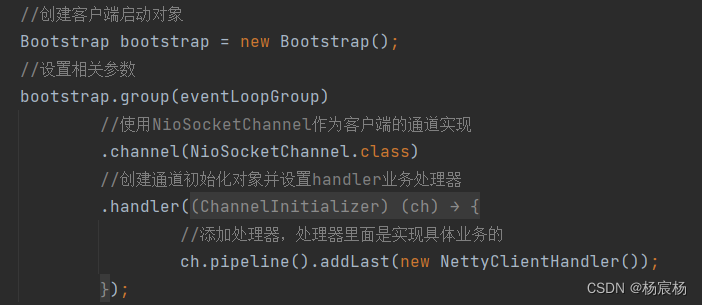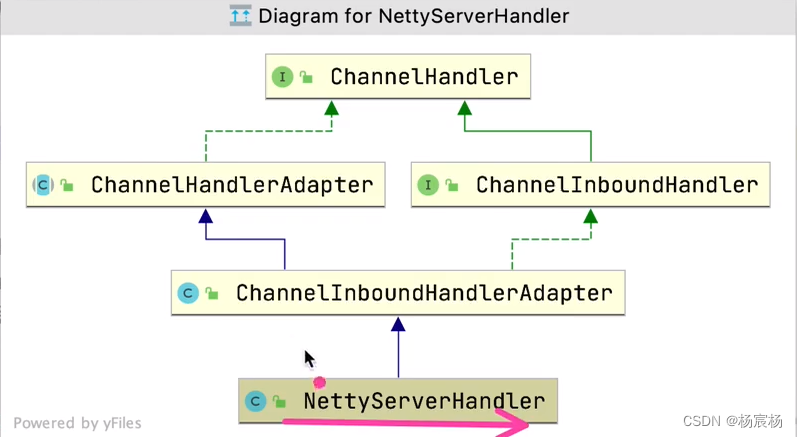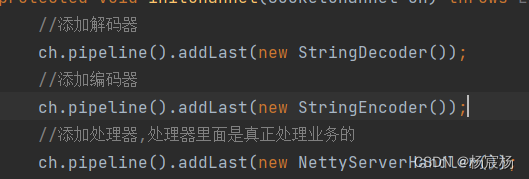Netty
- Bootstrap和ServerBootstrap
- Future和ChannelFuture
- Channel
- Selector
- NioEventLoop和NioEventLoopGroup
- ByteBuf
- 示例代码
- Channel相关组件
- 入站详情
- 出站详情
- 对象编解码
- ProtoBuf和ProtoStuff
- netty实现群聊系统
- 粘包和拆包
- TCP协议特点
- 举个例子
Bootstrap和ServerBootstrap
Bootstrap是Netty的启动程序,一个Netty应用通常由一个Bootstrap开始。Bootstrap的主要作用是配置Netty程序,串联Netty的各个组件。

Future和ChannelFuture
 这个方法是异步的(交给别的线程去执行该任务),当执行到这之后,netty不一定启动了
这个方法是异步的(交给别的线程去执行该任务),当执行到这之后,netty不一定启动了
ChannelFuture channelFuture = bootstrap.bind(9090);
channelFuture.addListener(new ChannelFutureListener() {@Overridepublic void operationComplete(ChannelFuture funture) throws Exception {if(funture.isSuccess()){System.out.println("监听9090成功");}else{System.out.println("监听9090失败");}}
});
该方法可以知晓有没有启动成功,或者改为同步的方式
ChannelFuture channelFuture = bootstrap.bind(9090).sync();

ChannelFuture和Future的子类,提供了针对于Channel的异步监听操作
Channel
NioSocketChannel:异步的客户端才CP Socket连接通道
NioServerSocketChannel:异步的服务端TCP Socket连接通道
NioDatagramChannel:异步的UDP连接通道
NioSctpChannel:异步的客户端Sctp连接通道
NioSctpServerChannel:异步的服务端Sctp连接通道
Selector
通过Selector多路复用器实现IO的多路复用。Selector可以监听多个连接的Channel事件,同时可以不断的查询已注册Channel是否处于就绪状态,实现一个线程可以高效的管理多个Channel。
NioEventLoop和NioEventLoopGroup
NioEventLoop本质就是一个线程,一个NioEventLoop就对应一个线程,但可以达到异步的处理事务,因为NioEventLoop内部维护了一个异步任务队列,用于存储需要在事件循环中执行的任务。通过将任务添加到队列中,NioEventLoop可以在空闲时间执行这些任务,从而实现了异步提交事务的能力。
NioEventLoopGroup管理NioEventLoop的生命周期,可以理解为是线程池,内部维护了一组线程。每个线程(即NioEventLoop)负责处理多个Channel上的事件。注意,一个Channel只对应一个线程,NioEventLoop和Channel它们是一对多的关系。
一个线程可以管理多个channel,但一个channel只能被一个线程执行
ByteBuf
初始情况

写入数据

读取数据

已读的区域:[0,readerIndex]
可读的区域:[readIndex,writeIndex)
可写的区域:[writeIndex,capacity)
示例代码
public class ByteBufDemo {public static void main(String[] args) {//创建一个有10个容量数据的ByteBuf对象ByteBuf buf = Unpooled.buffer(10);System.out.println("init buf:"+buf);//添加数据for(int i = 0;i<5;i++){buf.writeByte(i);}System.out.println("after write:"+buf);//按照索引读取数据for(int i = 0;i<3;i++){System.out.println(buf.getByte(i));}System.out.println("after get:"+buf);//读取数据for(int i = 0;i<3;i++){System.out.println(buf.readByte());}System.out.println("after read:"+buf);}
}
Channel相关组件

ChannelHandler
ChannelHandler用于处理拦截IO事件,往往在ChannelHandler中可以加入业务处理逻辑。ChannelHandler执行完后会将io事件转发到ChannelPipeline中的下一个处理程序。
ChannelHandlerContext
保存Channel相关的上下文信息,并关联一个ChannelHandler对象。
ChannelPipeline
ChannelPipeline是一个双向链表,其中保存着多个ChannelHandler。ChannelPipeline实现了一种高级形式的过滤器模式,在IO操作时发生的入站和出站事件,会导致ChannelPipeline中的多个ChannelHandler被依次调用。
入站详情


现在我们的客户端和服务端之间就有三个拦截器
我们在NettyServerHandler里面收到信息就不用解码了,为什么,因为解码器的拦截器已经帮我们做好了

当我们服务端读数据的时候,会从客户端读数据==入站,因为解码的handler和业务处理的handler是入站拦截器,所以会对数据产生作用,但编码的handler不会,因为它是一个出站handler
出站详情
站在服务端的立场

在Netty中,客户端和服务端的addLast方法有一些不同之处。具体来说,它们的区别如下:
1. 顺序:当调用addLast方法添加处理器时,它们的顺序略有不同。对于客户端来说,添加的处理器是按照添加的顺序进行顺序执行的,即先添加的处理器先执行。而对于服务端来说,添加的处理器是按照逆序执行的,即先添加的处理器后执行。
2. 作用对象:客户端的addLast方法主要作用于Outbound事件,用于处理从客户端发送到服务端的请求。而服务端的addLast方法主要作用于Inbound事件,用于处理从服务端接收到的请求。
3. 处理逻辑:客户端和服务端的addLast方法所添加的处理器,通常具有不同的处理逻辑。客户端的处理器通常用于编码请求、发送请求等操作。服务端的处理器通常用于解码请求、处理请求、编码响应等操作。
对象编解码
对象编码器

对象解码器

ProtoBuf和ProtoStuff
为了编解码提升性能,可以使用Protobuf域者Protpstuff对数据进行序列话和反序列化,效率更高。
第一步:导入依赖
<dependency><groupId>com.dyuproject.protostuff</groupId><artifactId>protostuff-api</artifactId><version>1.0.10</version>
</dependency><dependency><groupId>com.dyuproject.protostuff</groupId><artifactId>protostuff-core</artifactId><version>1.0.10</version>
</dependency><dependency><groupId>com.dyuproject.protostuff</groupId><artifactId>protostuff-runtime</artifactId><version>1.0.11</version>
</dependency>
第二步:引入工具类
public class ProtostuffUtils {/*** 避免每次序列化都重新申请Buffer空间*/private static LinkedBuffer buffer = LinkedBuffer.allocate(LinkedBuffer.DEFAULT_BUFFER_SIZE);/*** 缓存Schema*/private static Map<Class<?>, Schema<?>> schemaCache = new ConcurrentHashMap<>();/*** 序列化方法,把指定对象序列化成字节数组** @param obj* @param <T>* @return*/@SuppressWarnings("unchecked")public static <T> byte[] serialize(T obj) {Class<T> clazz = (Class<T>) obj.getClass();Schema<T> schema = getSchema(clazz);byte[] data;try {data = ProtostuffIOUtil.toByteArray(obj, schema, buffer);} finally {buffer.clear();}return data;}/*** 反序列化方法,将字节数组反序列化成指定Class类型** @param data* @param clazz* @param <T>* @return*/public static <T> T deserialize(byte[] data, Class<T> clazz) {Schema<T> schema = getSchema(clazz);T obj = schema.newMessage();ProtostuffIOUtil.mergeFrom(data, obj, schema);return obj;}@SuppressWarnings("unchecked")private static <T> Schema<T> getSchema(Class<T> clazz) {Schema<T> schema = (Schema<T>) schemaCache.get(clazz);if (Objects.isNull(schema)) {//这个schema通过RuntimeSchema进行懒创建并缓存//所以可以一直调用RuntimeSchema.getSchema(),这个方法是线程安全的schema = RuntimeSchema.getSchema(clazz);if (Objects.nonNull(schema)) {schemaCache.put(clazz, schema);}}return schema;}
}
netty实现群聊系统
服务端基本代码
//群聊系统的服务器
public class ChatServer {public static void main(String[] args) throws Exception {EventLoopGroup boosGroup = new NioEventLoopGroup(1);EventLoopGroup workerGroup = new NioEventLoopGroup();ServerBootstrap serverBootstrap = new ServerBootstrap();//配置参数serverBootstrap.group(boosGroup,workerGroup).channel(NioServerSocketChannel.class).option(ChannelOption.SO_BACKLOG,1024).childHandler(new ChannelInitializer<SocketChannel>() {@Overrideprotected void initChannel(SocketChannel ch) throws Exception {//获得piplelineChannelPipeline pipeline = ch.pipeline();//添加handlerpipeline.addLast(new StringDecoder());pipeline.addLast(new StringEncoder());//添加业务处理handlerpipeline.addLast(new ChatServerHandler());}});System.out.println("聊天室启动了...");ChannelFuture channelFuture = serverBootstrap.bind(9090).sync();channelFuture.channel().closeFuture().sync();boosGroup.shutdownGracefully();workerGroup.shutdownGracefully();}
}
服务端业务代码
public class ChatServerHandler extends SimpleChannelInboundHandler<String>{private SimpleDateFormat sdf = new SimpleDateFormat("yyyy-MM-dd HH:mm:ss");//存放Channel的容器,而且还可以执行对每个channel执行的任务private static ChannelGroup channelGroup = new DefaultChannelGroup(GlobalEventExecutor.INSTANCE);//有客户端上线了//有新的客户端连接了,将该客户端的上线信息广播给其它所有客户端@Overridepublic void channelActive(ChannelHandlerContext ctx) throws Exception {//得到客户端的channelChannel channel = ctx.channel();String message = "客户端-"+channel.remoteAddress()+"于"+sdf.format(new Date())+"上线了\n";//得到其它客户端的channel向其它客户端发送该客户端的channelchannelGroup.writeAndFlush(message);//加入到channelGroup中channelGroup.add(channel);}/** 客户端下线则广播给其它客户端*/@Overridepublic void channelInactive(ChannelHandlerContext ctx) throws Exception {Channel channel = ctx.channel();//生成一个下线的信息String message = "客户端-"+channel.remoteAddress()+"于"+sdf.format(new Date())+"下线了\n";//广播给其它客户端channelGroup.writeAndFlush(message);}/**具体读数据的业务 */@Overrideprotected void channelRead0(ChannelHandlerContext ctx, String msg) throws Exception {//获得当前发消息的客户端channelChannel channel = ctx.channel();//遍历所有的channelchannelGroup.forEach(ch->{if(channel!=ch){ch.writeAndFlush("客户端-"+channel.remoteAddress()+"于"+sdf.format(new Date())+"说:"+msg+"\n");}else{ch.writeAndFlush("我于"+sdf.format(new Date())+"说:"+msg+"\n");}});}@Overridepublic void exceptionCaught(ChannelHandlerContext ctx, Throwable cause) throws Exception {super.exceptionCaught(ctx, cause);}
}
客户端基本代码
public class ChatClient {public static void main(String[] args) throws Exception {EventLoopGroup eventLoopGroup = new NioEventLoopGroup();Bootstrap bootstrap = new Bootstrap();bootstrap.group(eventLoopGroup).channel(NioSocketChannel.class).handler(new ChannelInitializer<SocketChannel>() {@Overrideprotected void initChannel(SocketChannel ch) throws Exception {ChannelPipeline pipeline = ch.pipeline();pipeline.addLast(new StringDecoder());pipeline.addLast(new StringEncoder());pipeline.addLast(new ChatClientHandler());}});//发送消息ChannelFuture channelFuture = bootstrap.connect("127.0.0.1", 9090).sync();Channel channel = channelFuture.channel();System.out.println("欢迎进入Yc聊天室");Scanner scanner = new Scanner(System.in);while (scanner.hasNextLine()){String message = scanner.nextLine();channel.writeAndFlush(message);}eventLoopGroup.shutdownGracefully();}
}
客户端业务代码
public class ChatClientHandler extends SimpleChannelInboundHandler<String> {//打印在控制台@Overrideprotected void channelRead0(ChannelHandlerContext channelHandlerContext, String s) throws Exception {System.out.println(s);}
}
粘包和拆包
TCP协议特点
作为一个流式传输协议,数据在TCP中传输是没有边界的。也就是说,客户端发送的多条数据,有可能会被认为是一条数据。或者,客户端发送的一条数据,有可能会被分成多条数据。这是由于TCP协议并不了解上层业务数据的具体含义,在使用TCP协议传输数据时,是根据TCP缓冲区的实际情况进行数据包的划分。
举个例子
我们要发两句话
我是杨 他是李
可能别人收到的信息就是我是杨他是李一条数据,也可能收到我是 杨他是李这两句话
假设我们这有个客户端

发送两百次消息

就可能得到这样的结果
粘包:缓冲区还可以放的下 拆包:缓冲区不可以放的下(乱码发生的原因是因为一个字的字节放在不同缓冲区内发送)


![[运维|系统] debian系系统设置本地编码](http://pic.xiahunao.cn/[运维|系统] debian系系统设置本地编码)


——QComboBox)











)
)

